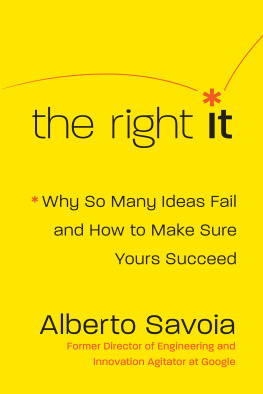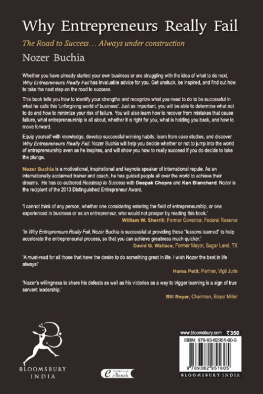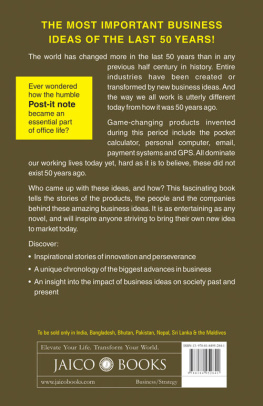Care has been taken to confirm the accuracy of the information presented and to describe generally sound and accepted practices and techniques. However, neither the author nor the publisher shall be held liable or responsible to any person or entity with respect to any loss or incidental or consequential damages caused, or alleged to be caused, directly or indirectly by the information contained therein.
THE RIGHT IT . Copyright 2019 by Alberto Savoia. All rights reserved under International and Pan-American Copyright Conventions. By payment of the required fees, you have been granted the nonexclusive, nontransferable right to access and read the text of this e-book on-screen. No part of this text may be reproduced, transmitted, downloaded, decompiled, reverse-engineered, or stored in or introduced into any information storage and retrieval system, in any form or by any means, whether electronic or mechanical, now known or hereafter invented, without the express written permission of HarperCollins e-books.
Library of Congress Cataloging-in-Publication Data is available upon request.
It was 3 a.m., but I was too agitated to fall asleep. In six hours I would be sitting in the final board meeting for the company I had cofounded. After five years of hard work and several attempts to make our business work, we had no options but to accept a fire-sale offerpennies on the dollarfor our award-winning technology and assets. Dozens of people I had hired, people who had put their trust in me and my vision, would be out of a job. The three world-class venture capitalists who had entrusted us with not only a $25 million investment but also their time, connections, and advice would be staring angrily at me, my cofounder, and our executive team. I had been bitten by the Beast of Failure, and it hurt like hell.
What hurt the most was that I could not figure out where I had gone wrong. Failure was something that only affected other people: less experienced, less competent, and less well-prepared people. Until then I had a perfect record with startups and entrepreneurship. I was an early employee and had a great career at two fledgling companies that eventually became industry giants (Sun Microsystems and Google). I had also cofounded a venture capitalbacked company that managed to turn a $3 million investment into a $100 million acquisition in eighteen months. My record was a perfect 3 and 0, and I was sure that win number 4 was just a matter of time. The formula was easy: identify an idea for a new product or service that solves a big problem, assemble a strong team, get venture funding, build the idea, launch it, and then go public orworst caseget acquired for a pile of money.
And we had done all that. We had an ambitious idea for a product that addressed a major software engineering problem in a very innovative way. All our due diligence and market research confirmed that companies needed, wanted, and would buy our product for their developers. We had assembled a team of amazing people who worked incredibly hard for five years. We had a great business plan and plenty of funding from the best venture capitalists (VCs) in the world to execute itand we executed it, just as planned.
So, WTF? Why The Failure? Where did we go wrong?
Unable to sleep, I got out of bed and stared out the window thinking of all the other people who were, had been, or would soon be in a similar predicament. It was a sobering thought.
At this very moment, millions of people around the world are working hard to bring to life new ideas that, when launched, will be successful. Some of these ideas will turn out to be stunning successes that will have a major impact on our world and our culture: the next Google, the next polio vaccine, the next Harry Potter series, the next Red Cross, the next Ford Mustang. Others will be smaller, more personal, but no less meaningful successes: a little restaurant that becomes a neighborhood favorite, a biography that does not make the bestseller list but tells an important story, a local nonprofit that cares for abandoned pets.
At this very same moment, many other people are working equally hard to develop new ideas that, when launched, will fail. Some of them will fail spectacularly and publicly: like New Coke, the movie John Carter, or the Ford Edsel. Others will be smaller, more private, but no less painful failures: a home-based business that never takes off, a childrens book that neither publishers nor children have any interest in, a charity for a cause that too few people care enough about.
If you are currently working to develop a new idea, whether on your own or as part of a team, which group are you in? Or if at this moment you are still only thinking about investing to develop a new idea, which group will you be in?
Most people believe that they either are or will be in the first groupthe group whose ideas will be successful. All they have to do is work hard and execute well. Unfortunately, we know that this cannot be the case. Most new products, services, businesses, and initiatives will fail soon after they are launchedregardless of how promising they sound, how much their developers commit to them, or how well they execute them.
This is a hard fact to accept. We believe that other people fail, because they dont know what they are doing. They are losers who have no business being in that business. Somehow, we believe that this does not apply to us and to our ideaespecially if weve experienced victories in the past: I am a winner. I was successful before. I will be successful againjust watch me!
That is how I used to think. And I believed I had good reasons for my smugness, because I had experienced a string of successes with only a few relatively minor setbacks. Failure was something that only affected other people.
And then, just as I had reached new heights of confidence and hubris, the Beast of Failure wrapped its tentacles around me and bit me in the ass. A good, hard-to-ignore, and impossible-to-forget bite on that smart, competent, and well-prepared ass of mine.
I could lick my wounds or bite back. I decided to bite back.
Failure became my nemesis. Defeating it, my obsession. Teaching others how to defeat it, my mission.
This book is part of that mission.
I am a practical guy, and this is a practical book. I believe that the best way to accomplish goals, deal with challenges, and solve problems is to approach them with the proper combination of facts, tools, and tactics. And thats exactly how this book is organized.
Part I: Hard Facts
The initial set of chapters is my version of the birds and the bees talk you may have had to endure when you were a child. But instead of explaining how babies are born (and other facts of life), I will explain how new product ideas are hatchedand what fate awaits themusing my own set of metaphors.
To begin with, we take an unflinching look at the Law of Market Failure in . It wont be a pretty sight. The gauntlet that awaits most new ideas might remind you of one of those hard-to-watch scenes in nature documentaries, like the one where they show hundreds of newly hatched sea turtles race from the beach to the surf, while all sorts of predators pick them off, one by one, like mini-quiches at a buffet. Only a few lucky baby turtles make it to the water, and even fewer reach maturity. Mother Nature is brutaland so is the market. Before we can consistently beat failure, we need to study it and understand it.








